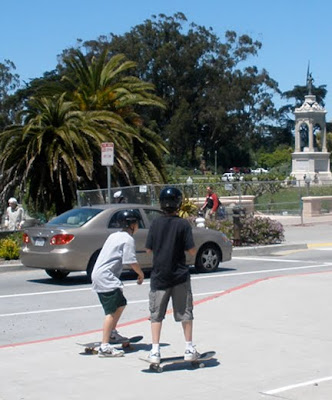It was a beautiful day, and there were many people just walking along, enjoying the scenery, including this young lady who was walking her dog.

The dog took a fancy to Cliff,
and I think the attraction was mutual.

This building is where we were headed. Note that bump on the
room clear to the left. We'll be up there shortly.
room clear to the left. We'll be up there shortly.

No wonder the garage was full!
All these people!

Many tourists ...

including kids on skateboards

like these.

This is this the concert shell, and there was a concert going on.
This shot was taken from the roof of the
Academy of Sciences.
This shot was taken from the roof of the
Academy of Sciences.

An open-air observation terrace enables visitors to get a close-up look at the roof's lush canopy of plants. The view encompasses the densest concentration of native wildflowers in San Francisco. The expansive vista is also an ideal location for watching Northern
California’s birds, butterflies and insects.
California’s birds, butterflies and insects.
That dark building across the way is the rebuilt DeYoung art museum. Those blue dots
at the bottom of the photo are part of the solar canopy which contains 60,000 photo voltaic cells.
at the bottom of the photo are part of the solar canopy which contains 60,000 photo voltaic cells.

Skylights above the larger domes open and close throughout the day, enabling sunlight to reach the exhibits below. The steep slopes of the rooftop's hills draw cool air into the open piazza at the center of the building. Weather stations on the roof monitor wind, rain, and changes in temperature to help inform the automated passive ventilation systems.

The more typical black tar-and-asphalt building rooftop leads to a phenomenon called the “Urban Heat Island” effect. The endless swath of black rooftops and pavement trap heat, causing cities to be 6 to 10 degrees warmer than outlying greenbelt areas. One-sixth of all electricity consumed in the U.S. goes to cool buildings. The Academy's green rooftop keeps the building's interior an average of 10 degrees cooler than a standard roof would. The plants also transform carbon dioxide into oxygen, capture rainwater, and reduce energy needs for heating and cooling.

Assembling a 197,000-square-foot rooftop to accommodate a living tapestry of native plant species is challenging enough. Add to that the technical problems posed by the roof's extreme dips and slopes. How to keep the plants and soil from sliding off? The developers patented a solution called the BioTray®. They used 50,000 porous, biodegradable trays made from tree sap and coconut husks as containers for the vegetation. These trays line the rooftop like tile, yet enable the roots to grow and interlock, binding the trays together like patchwork.
I was told there was an elevator that would get me to the Living Roof in my scooter, but when Cliff and I reached the third level, we discovered a flight of steps leading to the roof. So I handed the camera to Cliff, and asked him to go up and take some shots. I waited below. Then I was told I’d taken the wrong elevator to the roof by a young lady employee who
was bringing up some of these BioTray®.
I was told there was an elevator that would get me to the Living Roof in my scooter, but when Cliff and I reached the third level, we discovered a flight of steps leading to the roof. So I handed the camera to Cliff, and asked him to go up and take some shots. I waited below. Then I was told I’d taken the wrong elevator to the roof by a young lady employee who
was bringing up some of these BioTray®.

The Living Roof´s 1.7 million native plants were specially chosen to flourish in Golden Gate Park´s climate. After experimenting with thirty native species, the finalists were all able to self-propagate. Nine species, located inside and outside of the special exhibit, will thrive with little water, resist the salt spray from ocean air, and tolerate wind. The roof will provide habitat for a wide variety of wildlife. A future project will seek to introduce the endangered San Bruno elfin butterfly and the Bay checkerspot butterfly to this new habitat.

Fun --
On our way home Saturday we passed a sign on the highway:
BIG TREES
STUPID PRICES
* * *
Go on the 30 day diet. (I'm on it and so far I've lost 15 days).
***
The trouble with bucket seats is that not everyone has the same size bucket.
Tomorrow: Inside the building.
VERY cool! I've been inside the new DeYoung so far, but that's it. Thank you for the tour. (And of course the dog liked Cliff. Dogs are smart--they know who's kind and friendly.)
ReplyDeleteOh WOw! I really want to go there now!
ReplyDeleteLooks like an amazing place! Glad to see the rain stayed away, too.
ReplyDelete